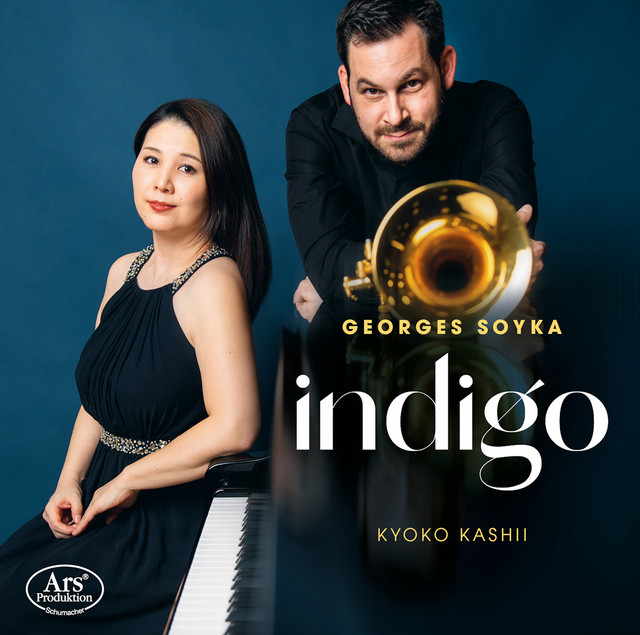Ähnlich wie Alexander Scriabin ist der Luxemburger Trompeter Georges Soyka Synästhetiker. Er assoziiert Musik und Klänge mit bestimmten Farben, und hat sich für sein Album den Blau-Ton Indigo ausgesucht. Er steht für den Musiker, für Wahrheit, für Intuition und ganzheitliches Denken (mehr dazu steht im Booklet).
Viele dieser Eigenschaften finden sich auch in den Interpretationen auf dieser CD wieder. Georges Soyka hat sich – mit Ausnahme von Massenet – für Musik aus dem 20. und 21. Jahrhundert entschieden, ein Programm abseits eingetretener Pfade, mit einer neuen, ihm gewidmeten Komposition, Jay von Yann Windeshausen.
Soykas’ Spiel ist alles andere als klischeehaft und bietet nicht exklusiv rauschende Virtuosität und scharfe, strahlende Klänge. Seine Trompete hält ein ganzes Arsenal an Klangschattierungen bereit, die den durchweg kurzen Werken einen jeweils individuellen Charakter verleihen, dies stets in totaler musikalischer und gedanklicher Übereinstimmung mit der Pianistin Kyoko Kashii.
Die eröffnende Schnyder-Sonate wird mit stechend kantigen Rhythmen eingeleitet, die dann nahtlos in wunderbar lyrische Introspektion übergehen.
In der Gavotte von Sutermeister legt der stellenweise gedämpfte Ton sich wie ein Schleier über die Musik, ehe es zurückgeht in den Perpetuum-Mobile-Modus.
Eher verspielt und keck kommt die Komposition von Georges Soykas Schüler Yann Windeshausen daher: Jay – ein Eichelhäher lautmalerisch pfiffig dargestellt.
In der Hubeau-Sonate kommt zudem auch Soykas feines Jazz-Feeling zu Tage – insbesondere im abschließenden Spiritual in bester Swing-Atmosphäre.
Wer feine, größtenteils zeitgenössische Kammermusik für Trompete hören will, ist bei dieser Produktion bestens aufgehoben. ‘C’est ainsi que tu es’ – lautet der Titel eines zweiminütigen Poulenc-Werkes. Er könnte ebenso gut für die Klangvielfalt der Trompete und das facettenreiche Spiel von Georges Soyka stehen.
Similar to Alexander Scriabin, Luxembourg trumpeter Georges Soyka is a synesthete. He associates music and sounds with certain colors, and has chosen the blue hue Indigo for his album. It stands for the musician, for truth, for intuition and holistic thinking (more about this in the booklet).
Many of these qualities are also found in the interpretations on this CD. With the exception of Massenet, Georges Soyka has chosen music from the 20th and 21st centuries, a program off the beaten path, with a new composition dedicated to him, Jay, by Yann Windeshausen.
Soykas’ playing is anything but clichéd, offering non-exclusive rushing virtuosity and sharp, radiant sounds. His trumpet holds a whole arsenal of tonal shadings, each of which lends an individual character to the consistently short works, always in total musical and intellectual accord with pianist Kyoko Kashii.
The opening Schnyder Sonata is introduced with piercingly angular rhythms that then transition seamlessly into wonderfully lyrical introspection.
In Sutermeister’s Gavotte, the muted tone in places settles like a veil over the music before it returns to perpetual motion mode.
The composition by Georges Soyka’s student Yann Windeshausen is more playful and perky: Jay – a jay onomatopoeically depicted in a smart way.
In the Hubeau Sonata, Soyka’s fine jazz feeling also comes to light – especially in the concluding spiritual in the best swing atmosphere.
If you want to hear fine, largely contemporary chamber music for trumpet, this production is for you. ‘C’est ainsi que tu es’ – is the title of a two-minute Poulenc work. It could just as well stand for the variety of sounds of the trumpet and the multi-faceted playing of Georges Soyka.




















